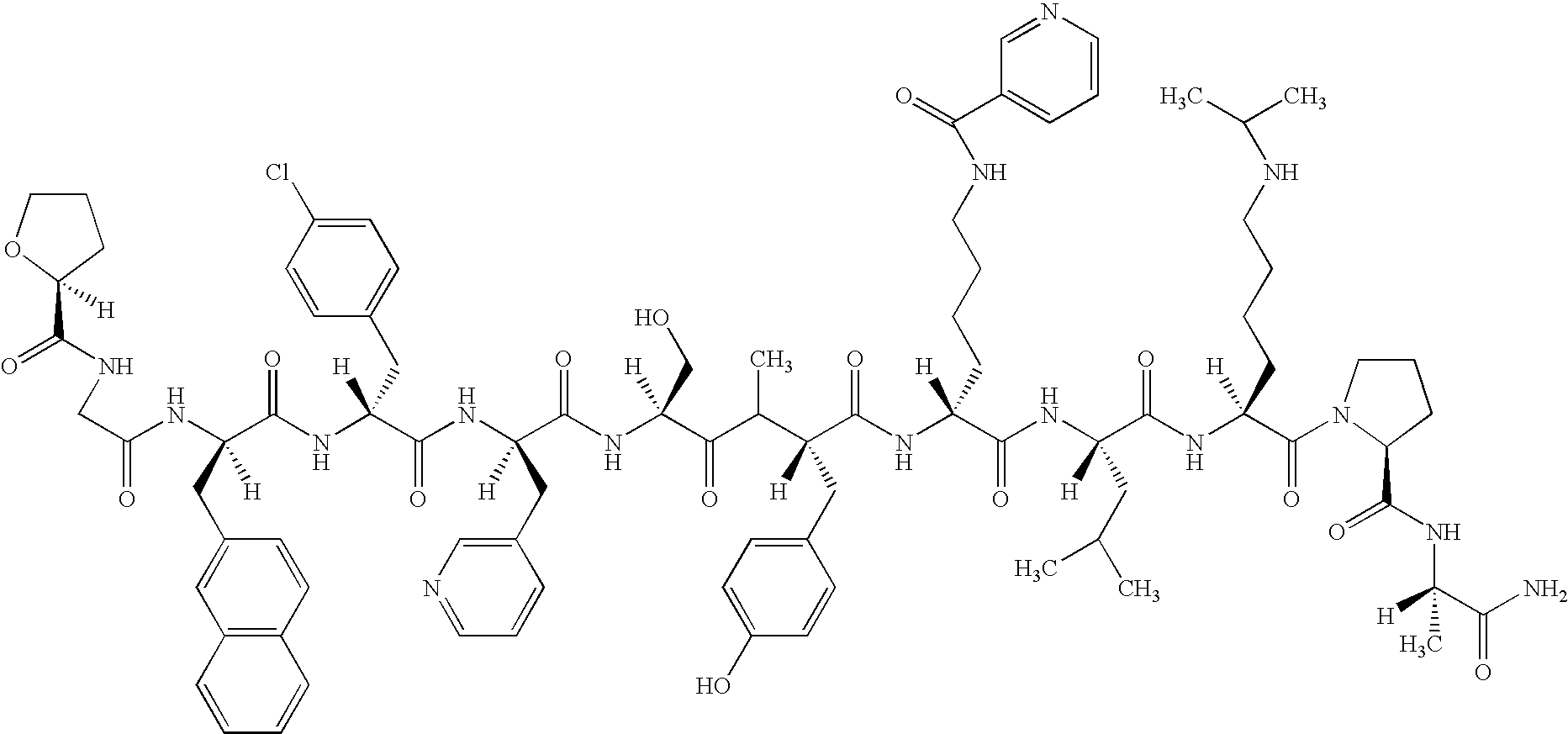Sustained release compositions, process for producing the same and utilization thereof
- Summary
- Abstract
- Description
- Claims
- Application Information
AI Technical Summary
Benefits of technology
Problems solved by technology
Method used
Image
Examples
example 1
3,429.6 mg of the acetate (produced by TAP) of N-(S)-tetrahydrofur-2-oyl-Gly-D2Nal-D4ClPhe-D3Pal-NMeTyr-DLys(Nic)-Leu-Lys-(Nisp)-Pro-DAlaNH.sub.2 (hereinafter referred to as peptide A (SEQ ID NO.: 4))
(Chemical Formula of Peptide A) ##STR2##
and 685.2 mg of 3-hydroxy-2-naphthoic acid were dissolved in 15 ml of ethanol. This solution was gradually distilled by means of a rotary evaporator to evaporate the organic solvent. This residue was again dissolved in 5.5 ml of dichloromethane and poured in 400 ml of a 0.1% (w / w) aqueous solution of polyvinyl alcohol (EG-40, produced by The Nippon Synthetic Chemical Industry), previously adjusted to 18.degree. C.; the solution was stirred at 8,000 rpm, using a turbine type homomixer, to yield an O / W emulsion. This O / W emulsion was stirred at room temperature for 3 hours to volatilize the dichloromethane and solidify the oil phase, followed by microsphere collection at 2,000 rpm using a centrifuge (05PR-22, Hitachi, Ltd.). The microspheres were ag...
example 2
1,785.1 mg of the acetate of peptide A and 1,370.4 mg of 3-hydroxy-2-naphthoic acid were dissolved in 15 ml of ethanol. This solution was gradually distilled by means of a rotary evaporator to evaporate the organic solvent. This residue was again dissolved in 10 ml of dichloromethane and poured in 1,000 ml of a 0.1% (w / w) aqueous solution of polyvinyl alcohol, previously adjusted to 18.degree. C.; the same procedures as those in Example 1 were followed to yield microspheres. The recovery rate was 58%, the peptide A content and 3-hydroxy-2-naphthoic acid / peptide A molar ratio in the microspheres were 54.3% and 6.15, respectively.
example 3
1,800 mg of the acetate of peptide A, 173 mg of 3-hydroxy-2-naphthoic acid, and 2 g of a lactic acid-glycolic acid copolymer (lactic acid / glycolic acid=50 / 50 (mol %), weight-average molecular weight 10,100, number-average molecular weight 5,670, number-average molecular, (weight 3,720, as determined by terminal group quantitation, produced by Wako Pure Chemical Industries) were dissolved in a mixture of 6 ml of dichloromethane and 0.2 ml of ethanol. This solution was poured into 900 ml of a 0.1% (w / w) aqueous solution of polyvinyl alcohol containing 5% mannitol, previously adjusted to 18.degree. C., and stirred at 7,000 rpm using a turbine type homomixer to yield an O / W emulsion. This O / W emulsion was stirred at room temperature for 3 hours to volatilize the dichloromethane and ethanol and solidify the oil phase, followed by microsphere collection at 2,000 rpm using a centrifuge. The microspheres were again dispersed in distilled water, after which centrifugation was conducted, and ...
PUM
| Property | Measurement | Unit |
|---|---|---|
| Fraction | aaaaa | aaaaa |
| Fraction | aaaaa | aaaaa |
| Fraction | aaaaa | aaaaa |
Abstract
Description
Claims
Application Information
 Login to View More
Login to View More - R&D
- Intellectual Property
- Life Sciences
- Materials
- Tech Scout
- Unparalleled Data Quality
- Higher Quality Content
- 60% Fewer Hallucinations
Browse by: Latest US Patents, China's latest patents, Technical Efficacy Thesaurus, Application Domain, Technology Topic, Popular Technical Reports.
© 2025 PatSnap. All rights reserved.Legal|Privacy policy|Modern Slavery Act Transparency Statement|Sitemap|About US| Contact US: help@patsnap.com


